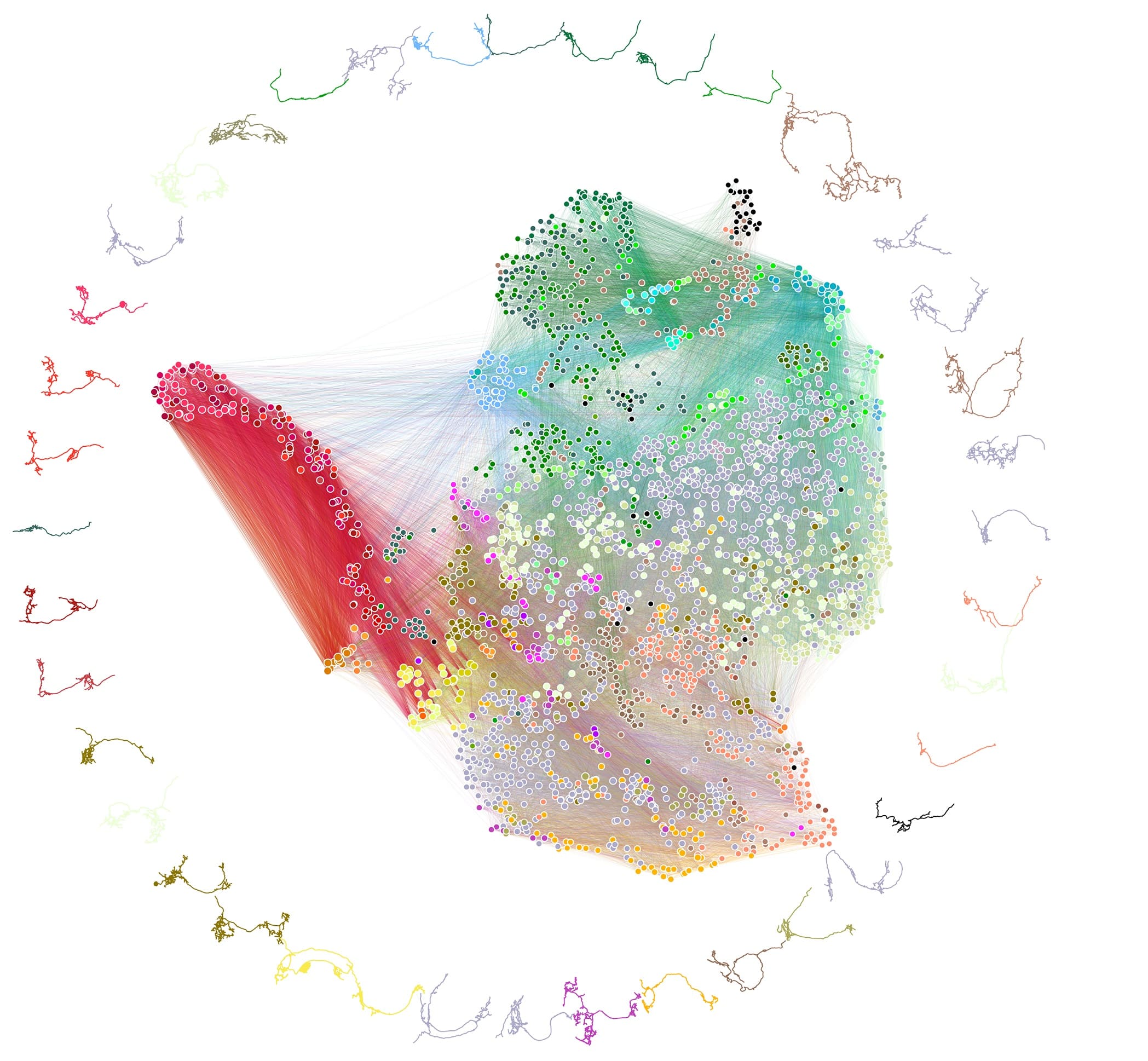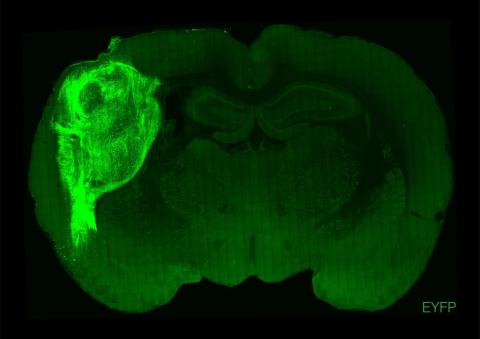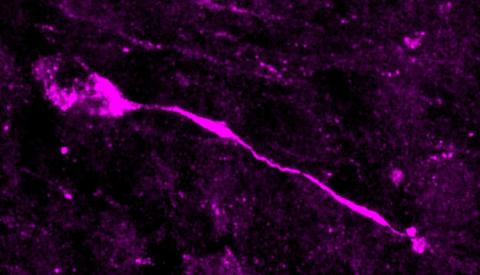Reactions: first whole-brain connectome of an insect brain obtained
Researchers have presented the first connectome - a diagram of neural connections - of the whole brain of an insect, a vinegar fly larva (Drosophila melanogaster). The work, which the authors say will inspire new studies of neural circuits and machine learning architectures, is published today in Science.

Diagram of neuronal connections: neurons are represented as dots and those with more similar connectivity are closer together, while lines represent connections. Examples of neuronal morphologies are shown at the edges. Authors: Johns Hopkins University/Cambridge University.
Rafael Yuste - conectoma larva EN
Rafael Yuste
Professor of Biological Sciences and Director of the Center for NeuroTechnology at Columbia University (New York), President of the NeuroRights Foundation and promoter of the BRAIN project
I think the work is spectacular. It is rigorous and of good quality. It is a study that falls under the umbrella of connectomics, a new neurotechnology for systematically reconstructing the brains of different animals using automated electron microscopy techniques. This began with the pioneering and almost heroic work of White in Brenner's Cambridge lab, in a paper they humorously called "The Mind of the Worm", precisely when I was working there, and has now become an almost industrial process, involving large groups of biologists, microscopists, engineers and even large technology companies, with inexorable progress to brains of ever more complex species.
These data are important for understanding brain computations and how they generate behaviour. In fact, the maps of the Drosophila brain have already led to several first-level studies explaining the information processing mechanism of its neural circuits. Drosophila was introduced to biology in Morgan's lab, in my own department at Columbia University, over 100 years ago and revolutionised genetics. I think Morgan would pop the champagne now because Drosophila, with this push to map all the connections in its larvae, can also revolutionise neuroscience.
It is very difficult to carry out these studies, you need huge teams, with a lot of investment of time and labour. That is why it is important to coordinate national and international funding and efforts in neurotechnology. Mapping the mouse connectome is being studied in a worldwide collaboration. These methods are also starting to be used in the human brain, but in a very early stage.
Juan Lerma - conectoma larva EN
Juan Lerma
CSIC research professor at the Instituto de Neurociencias de Alicante (CSIC-UMH) and member of the Royal Academy of Sciences of Spain
This study is an exceptional tour de force in which the authors describe the map of nerve connections in the vinegar fly larva. This map has been determined in simpler animals with fewer neurons, such as the famous worm C. elegans. This has a few hundred neurons and its map of connections has long been known.
The work now published determines the connection map of more than 3,000 neurons that establish more than half a million contacts. It is not only a quantitative leap, but also a qualitative one, because nothing in the nervous system is linear. I think it is a fantastic piece of work that has taken many years to develop and that can be tremendously useful for understanding sophisticated principles of neural integration and computational rules that can be decisive in the progress of multiple aspects that are so fashionable today, such as artificial intelligence and deep learning.
Many neuroscientists believe that we cannot understand our brains without knowing exactly how they are organised. This is a widespread belief that was expressed by Cajal more than 100 years ago. Determining neural connectivity, i.e. how the neural circuits are constructed, which neuron contacts which neuron, how often, is like drawing up a road map of a country, showing where there are motorways and where there are local roads. Only from such an examination can one infer what the social and economic relations are between the different population centres and regions. From examining this map of neural connections, now revealed to us, one can infer how the architecture of a circuit determines the generation of specific behaviours.
For example, one of the findings of this work is that there appears to be very profuse and frequent recurrent innervation in those circuits known to be involved in learning. This gives clues as to how nature organises neuronal elements with loops to make possible that marvellous function that is learning. Or, in other words, the existence of the organisation now revealed endows the system with the capacity to store information. Continuing with the example above, we will understand what we can learn from this organisation to improve the structure of machines and the learning algorithms and artificial intelligence they can use.
Naturally, this map reveals how the nervous system of a fly larva is organised, which at this level of development is similar to a worm, but with a higher level of complexity. But these larvae develop complex behaviours, interact, consult and explore the environment, learn and perform complex motor behaviours such as foraging, and so on. Naturally they are far from typical human behaviours, but history shows that general principles are just that, general, and studies in lower animals have shown us how the human brain works as well. For example, the mechanism by which a nerve impulse is generated and transmitted along a human nerve is exactly the same as in the nerve of a squid, a fly or a mouse. In fact, it was in the squid that all these mechanisms were discovered.
Javier Morante - conectoma larva EN
Javier Morante Oria
CSIC Group Leader at the Institute of Neurosciences (CSIC-UMH)
To publish the most complex full synaptic map of the brain to date, the researchers applied high spatial resolution and artificial intelligence techniques to reconstruct the complete map of the fly larva's brain.
The resolution of this map is such that it can not only visualise major highways and the cities they connect, but also secondary roads, smaller towns and even gas stations, toll booths and lighting points.
The size of the fly's brain compared to the human brain is like comparing a grain of sand to the whole desert, but this kind of approach will allow us to understand the basic principles that govern communication in the brain and to determine whether there are alterations that may influence its functioning. There are still many grains of sand to be discovered in the human brain!
Winding et al.
- Research article
- Peer reviewed
- Animals



